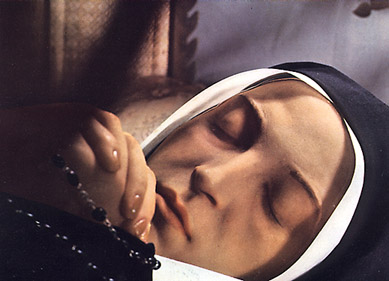 Here’s my latest article from the June issue of Catholic Insight magazine. Hope you like it!
Here’s my latest article from the June issue of Catholic Insight magazine. Hope you like it!
Debunking the Debunkers
by Cale Clarke
Just as surely as the lillies bloom every spring, each Easter season brings with it some new theories about what really happened at the first Easter. Martin Luther’s dictum describing early Protestantism comes to mind: “There are as many interpretations as there are heads”. Here are a couple of this year’s takes:
First, on Holy Saturday, the National Post ran a piece about a new book by art historian (and amateur theologian) Thomas de Wesselow, The Sign: The Shroud of Turin and the Secret of the Resurrection. And what, pray tell, is that secret? According to de Wesselow, the shroud really is the burial cloth of Jesus Christ – but get this: he thinks it was the shroud that the Apostles encountered after the death of Christ, not his resurrected body. Huh? So, when “doubting” Thomas stuck his hand in Jesus’ side, was he only wiggling his fingers through a hole in the sheet? Not sure this is the sort of stuff that inspires martyrdom.
And then there’s the perennial publicity hound Simcha Jacobovici (TV’s The Naked Archaeologist), who, along with James Cameron (whenever the latter is not tied up making bad movies about blue people or sinking boats), spends a lot of his time looking for the lost tomb of Jesus. It’s a project that has as much potential as the maiden Titanic voyage.
As real biblical scholar Craig Evans pointed out recently in The Huffington Post, the archaeological community scoffs at the idea that the tomb in the Jerusalem area that Jacobovici shows off in The Jesus Discovery belongs to Jesus of Nazareth. And, if Jesus’ bones are still in a tomb, then how does Jacobovici explain the fact that even the enemies of the early Christian movement say it’s empty? It seems as if The Naked Archaeologist has no clothes.
The fact is that the disciples claimed to have encountered the resurrected Jesus. People who days earlier had denied even knowing Jesus (like Peter) are, post-Easter, quite willing to lay down their lives for their conviction that Jesus lives. Skeptics, even persecutors like Saul the Pharisee (better known now as Paul the Apostle) claim to have had the same experience. After his death and burial, Jesus is said to have appeared to numerous individuals and groups of people over a 40-day period, including 500 people at one time (1 Corinthians 15:6). Forget about mass hallucinations – you can’t catch a hallucination like a common cold. And what these folks claimed was not even that they had seen a “vision” of Jesus – a category well accepted in Jewish circles.
No, what they claimed was not that they had seen a ghost, or even – sorry, Thomas de Wesselow – a shroud. They claimed to have experienced Jesus’ physical body, back from the dead. Transformed, yes, but still him, still sporting the crucifixion wounds as a type of I.D. Able to be touched, able to scarf down some food to make a point of his being corporeal (cf. Luke 24:36-43; Acts 10:41). A resurrection is a lot harder to prove than a vision. A “vision” of Jesus, encouraging the disciples to continue the mission, wouldn’t require an empty tomb. And preaching the resurrection in the very city where Jesus was crucified would have been impossible if the tomb were occupied. This is even more evident when one considers that the location of the tomb was no secret, not waiting thousands of years to be discovered by Cameron and Jacobovici – it belonged to Joseph of Arimathea, a member of the Sanhedrin, the very council which condemned Jesus to death, and a known public figure.
Could the disciples have stolen the body? That was, after all, the explanation proffered by the enemies of the nascent Church as to how the tomb came to be empty. But this view overlooks an important fact: the disciples died for their belief in the resurrection. True, many have died (and continue to do so) for what they believe to be true – suicide bombers, for instance. But no one in their right mind willingly would give their life for what they knew to be false. If the disciples really had Jesus’ body locked in the trunk of a car somewhere, I doubt they’d be in a hurry to get themselves crucified upside-down, or sawed in two.
Whatever one’s theory is about what happened that first Easter, one ought to at least take into account all the known facts of the case. But, unfortunately for a gullible public, the Jacobovicis and de Wesselows of the world have never let the facts get in the way of a good story.
Cale Clarke is the Director of The Faith Explained Seminars (TheFaithExplained.com), and the creator of The New Mass app.
 I guess you could say this is a “Wayback Wednesday” post, on today’s Feast of Our Lady of Lourdes. For whatever reason, an article I wrote a few years ago on Lourdes, Saint Bernadette (and her incorrupt body), and on the miraculous in general drew a lot of interest, and still does today. People remain utterly fascinated by the phenomenon at Lourdes, and, I think, by the possibility of the miraculous in general:
I guess you could say this is a “Wayback Wednesday” post, on today’s Feast of Our Lady of Lourdes. For whatever reason, an article I wrote a few years ago on Lourdes, Saint Bernadette (and her incorrupt body), and on the miraculous in general drew a lot of interest, and still does today. People remain utterly fascinated by the phenomenon at Lourdes, and, I think, by the possibility of the miraculous in general:

